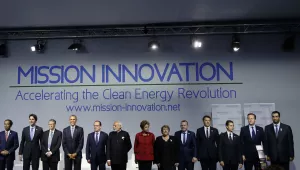Introduction
The United States needs to transform the way it produces and uses energy. This will require the improvement of current technologies and the development of new ones. To achieve the maximum payoff for public investments in energy technology innovation, the United States will need to improve and better align the management and structure of existing and new energy innovation institutions, and better connect R&D to demonstration and deployment. In what follows, we highlight three general and important recommendations for thinking about different initiatives, and we discuss the merits and challenges of current and new institutions, and the remaining gaps in the U.S. energy innovation system.
THREE GENERAL AND IMPORTANT RECOMMENDATIONS
COLLECTING METRICS AND INDICATORS FOR ASSESSING PROGRESS
It is imperative that all initiatives and institutions are required to consistently collect metrics on relevant outputs and outcomes and information about projects. This is essential to sustain public and political support, which will be necessary to ensure that the energy technology innovation effort enjoys the predictability and patience it needs. The U.K. Carbon Trust is an example of a relatively novel organization (it was created in the year 2001) that has achieved sustained political support—which has led to its exponential growth. This success was partly due to a decision that was made from its inception. The decision was to track the impact of their projects (which ranged from auditing services, VC investing, basic research support, demonstration projects, etc) using a consistent set of metrics directly linked to the institution’s mission: avoided CO2 emissions, and cost per ton of CO2 avoided. While we are not implying that these metrics are sufficient, the U.K. Carbon Trust experience is a testament to the value of collecting data suitable for evaluation from the start. Considerable thought is needed to design metrics that will drive effort in the right directions: with poor metrics, there is always a danger of managers focusing on meeting the metrics rather than the overall goal.
ALIGNING RD&D AND DEPLOYMENT PROGRAMS
Today, many of the specifics of energy research, development, and demonstration (RD&D) programs are decided by DOE headquarters, while many of the most important deployment incentives are decided in Congress or by federal and state standard-setting agencies. To maximize the return on federal investments in energy innovation, it is important to coordinate R&D programs with programs designed to encourage deployment in the marketplace, so that deployment supports are available when the products of RD&D are ready to make use of them.1
IMPROVING THE STRUCTURE AND MANAGEMENT OF ENERGY INNOVATION INSTITUTIONS
We maintain that it is possible to identify five elements that are essential to create and run a successful technology innovation institution. These elements, which have largely been absent in policy debates, are: having a clearly defined mission; attracting visionary and technically excellent leaders; cultivating an entrepreneurial and competitive culture; setting up a structure and management system that balances independence and accountability; and ensuring stable, predictable funding.2 These elements are useful guiding principles for thinking through the design of new institutions and the transformation of existing ones....
Download the entire policy memo below.
1 Anadon, Laura Diaz, Kelly Sims Gallagher, Matthew Bunn, and Charles Jones. "Tackling U.S. Energy Challenges and Opportunities: Preliminary Policy Recommendations for Enhancing Energy Innovation in The United States." Cambridge, Mass.: Report for Energy Technology Innovation Policy research group, Belfer Center for Science and International Affairs, Harvard Kennedy School, February 18, 2009.
2 Narayanamurti, V., Anadon, L.D., and Sagar, A.D. "Transforming Energy Innovation." Issues in Science & Technology, Fall 2009, pp. 57–64.
DOWNLOAD
Diaz Anadon, Laura, Matthew Bunn, Charles Jones and Venkatesh "Venky" Narayanamurti. “U.S. Public Energy Innovation Institutions and Mechanisms: Status & Deficiencies.” Science, Technology, and Public Policy Program, Belfer Center, January 14, 2010











